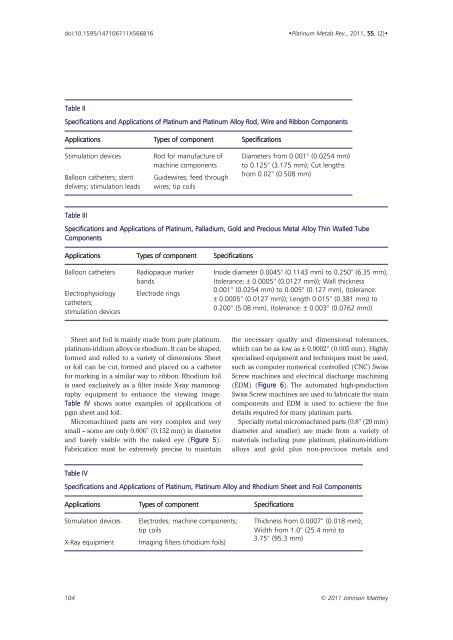Download - Platinum Metals Review
Download - Platinum Metals Review
Download - Platinum Metals Review
You also want an ePaper? Increase the reach of your titles
YUMPU automatically turns print PDFs into web optimized ePapers that Google loves.
doi:10.1595/147106711X566816<br />
•<strong>Platinum</strong> <strong>Metals</strong> Rev., 2011, 55, (2)•<br />
Table II<br />
Specifications and Applications of <strong>Platinum</strong> and <strong>Platinum</strong> Alloy Rod, Wire and Ribbon Components<br />
Applications Types of component Specifications<br />
Stimulation devices Rod for manufacture of Diameters from 0.001" (0.0254 mm)<br />
machine components to 0.125" (3.175 mm); Cut lengths<br />
Balloon catheters; stent Guidewires; feed through<br />
from 0.02" (0.508 mm)<br />
delivery; stimulation leads wires; tip coils<br />
Table III<br />
Specifications and Applications of <strong>Platinum</strong>, Palladium, Gold and Precious Metal Alloy Thin Walled Tube<br />
Components<br />
Applications Types of component Specifications<br />
Balloon catheters Radiopaque marker Inside diameter 0.0045" (0.1143 mm) to 0.250" (6.35 mm),<br />
bands<br />
(tolerance: ± 0.0005" (0.0127 mm)); Wall thickness<br />
0.001" (0.0254 mm) to 0.005" (0.127 mm), (tolerance:<br />
Electrophysiology Electrode rings<br />
± 0.0005" (0.0127 mm)); Length 0.015" (0.381 mm) to<br />
catheters;<br />
0.200" (5.08 mm), (tolerance: ± 0.003" (0.0762 mm))<br />
stimulation devices<br />
Sheet and foil is mainly made from pure platinum,<br />
platinum-iridium alloys or rhodium. It can be shaped,<br />
formed and rolled to a variety of dimensions. Sheet<br />
or foil can be cut, formed and placed on a catheter<br />
for marking in a similar way to ribbon. Rhodium foil<br />
is used exclusively as a filter inside X-ray mammography<br />
equipment to enhance the viewing image.<br />
Table IV shows some examples of applications of<br />
pgm sheet and foil.<br />
Micromachined parts are very complex and very<br />
small – some are only 0.006" (0.152 mm) in diameter<br />
and barely visible with the naked eye (Figure 5).<br />
Fabrication must be extremely precise to maintain<br />
the necessary quality and dimensional tolerances,<br />
which can be as low as ± 0.0002" (0.005 mm). Highly<br />
specialised equipment and techniques must be used,<br />
such as computer numerical controlled (CNC) Swiss<br />
Screw machines and electrical discharge machining<br />
(EDM) (Figure 6). The automated high-production<br />
Swiss Screw machines are used to fabricate the main<br />
components and EDM is used to achieve the fine<br />
details required for many platinum parts.<br />
Specialty metal micromachined parts (0.8" (20 mm)<br />
diameter and smaller) are made from a variety of<br />
materials including pure platinum, platinum-iridium<br />
alloys and gold plus non-precious metals and<br />
Table IV<br />
Specifications and Applications of <strong>Platinum</strong>, <strong>Platinum</strong> Alloy and Rhodium Sheet and Foil Components<br />
Applications Types of component Specifications<br />
Stimulation devices Electrodes; machine components; Thickness from 0.0007" (0.018 mm);<br />
tip coils<br />
Width from 1.0" (25.4 mm) to<br />
X-Ray equipment Imaging filters (rhodium foils)<br />
3.75" (95.3 mm)<br />
104 © 2011 Johnson Matthey
















